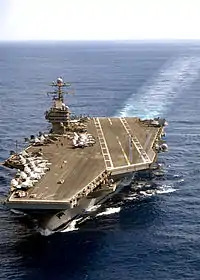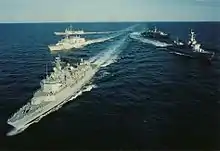List of NATO operations
Although the North Atlantic Treaty Organization (NATO) was present throughout the Cold War as the opposite to the Warsaw Pact, and conducted joint military exercises, no military operations took place. All military NATO operations have occurred after the Cold War when NATO's influence in a post-Cold War rose to prominence in Bosnia where NATO gradually stepped up their efforts to end the trouble. This culminated with NATO's first air campaign in 1995, Operation Deliberate Force, which targeted the Army of Republika Srpska whose presence in Bosnia posed a danger to United Nations "safe areas" and ultimately the bombing helped to bring about the Dayton Accords.
The organization now plays a prominent role in Afghanistan after the September 11 attacks in the United States invoked Article 5 of the North Atlantic Treaty which deemed the attacks to be an external attack on all NATO members under the idea of collective defense. Aside from continuing efforts in Afghanistan NATO has participated in a wide range of roles including relief effort, counter-piracy, enforcing no-fly zones and naval blockades.
Bosnia (1992–2004)
NATO was prominent in Bosnia during the early 1990s, and gradually its role became larger with some operations escalating, for instance Operation Sky Monitor turned into Operation Deny Flight which gave NATO "all measures necessary" to enforce a more stringent no-fly zone unlike Sky Monitor during which the no-fly zone was violated over 500 times. It took 46 years after NATO's inception in 1949 for the organization first ever military intervention took place in 1995, Operation Deliberate Force which was targeted the Army of Republika Srpska in Bosnia whose presence posed a danger to designated United Nations "safe areas". The air campaign helped bring about the Dayton Accords.


| Date | Operation | Location | Type | Information |
|---|---|---|---|---|
| 16 July 1992 – 22 November 1992 |
Operation Maritime Monitor | International waters off Serbia | Naval blockade | Naval blockade aimed at enforcing sanctions stipulated in UN Security Council Resolutions 713 and 757. |
| 16 October 1992 – 12 April 1993 |
Operation Sky Monitor (Resolution 781) |
No-fly zone | Established a no-fly zone over the airspace of Bosnia and Herzegovina. Effectiveness of the no-fly zone is debatable as by April 1993 500 violations (by all sides) of the no-fly zone had been recorded. NATO members voted for an "all necessary measures" resolution by the United Nations to allow NATO a mandate to enforce the no-fly zone more stringently. | |
| 22 November 1992 – 1993 | Operation Maritime Guard (Resolution 787) |
International waters in Adriatic Sea | Naval blockade | Authorized NATO to use force, and included stopping, inspecting, and diverting ships bound for the former Yugoslavia. All ships bound to or coming from the territorial waters of the former Yugoslavia were halted for inspection and verification of their cargoes and destinations. |
| 13 April 1993 – 20 December 1995 |
Operation Deny Flight (Resolutions 816 and 836) |
No-fly zone | Resolution 816 extended the ban to cover flights by all fixed-wing and rotary-wing aircraft over the country, and to use all measures necessary to ensure compliance with the ban. Resolution 836 authorized the use of force by UNPROFOR in the protection of specially designated UN "safe areas". | |
| 15 June 1993 – 2 October 1996 |
Operation Sharp Guard (Numerous resolutions) |
Naval blockade | A widespread naval blockade aimed at all former Yugoslavia. | |
| 30 August – 20 September 1995 |
Operation Deliberate Force | Air campaign | Involving approximately 400 aircraft, Deliberate Force targeted at the Army of Republika Srpska whose presence in Bosnia posed a danger to United Nations "safe areas". | |
| 20 December 1995 - 20 December 1996 |
Operation Joint Endeavour | Peacekeeping force | NATO-led Implementation Force(IFOR) peacekeeping force was established which was a force tasked with enforcing the peace under the Dayton Accords. | |
| 21 December 1996 - 19 June 1998 |
Operation Joint Guard | Peacekeeping force | NATO-led Stabilisation Force(SFOR) peacekeeping force which replaced the IFOR which was a force tasked with enforcing peace under the Dayton Accords. | |
| 20 June 1998 - 2 December 2004 |
Operation Joint Forge | Peacekeeping force | A continuation of Operation Joint Guard. | |
Serbia and Kosovo (1999–present)
| Date | Operation | Location | Type | Information |
|---|---|---|---|---|
| 24 March 1999 – 10 June 1999 |
Operation Allied Force | Air campaign | A sustained air campaign targeting infrastructure in Serbia and Serbian forces in Kosovo with the ulterior aim of getting the 'Serbs out [of Kosovo], peacekeepers in, refugees back' in the eyes of one NATO spokesman. The bombing lasted for nearly 3 months before all sides accepted the Kumanovo Treaty which ended the Kosovo War and the deployment of KFOR. The legitimacy of the NATO air campaign has been questioned[1] as too was the number of civilian casualties in the operation.[2] | |
| 12 June 1999 - Present |
KFOR | Peacekeeping force | A NATO-led Kosovo Force(KFOR) international peacekeeping force responsible for establishing a secure environment in Kosovo to enforce Resolution 1244. |
2001–present

_launching_a_Tomahawk_missile_in_support_of_Operation_Odyssey_Dawn_-_Cropped.jpg.webp)
| Date | Operation | Location | Type | Information |
|---|---|---|---|---|
| 9 October 2001 – 16 May 2002 |
Operation Eagle Assist | Aerial counter-terrorism | The 11 September attacks in the United States, a NATO member, invoked Article 5 of the North Atlantic Treaty. It remains the only time since NATO's inception that an attack from an external party or state has been deemed an attack on all NATO members. Operation Eagle Assist, which involved aerial patrols over the United States to prevent further attacks, was the first of two NATO operations undertaken in defense of the United States under Article 5.[3] | |
| 16 October 2001 – 9 November 2016 |
Operation Active Endeavor | Mediterranean Sea (confined to eastern Mediterranean prior to March 2004, entire sea thereafter)[3] | Maritime counter-terrorism and anti-trafficking | The 11 September attacks in the United States, a NATO member, invoked Article 5 of the North Atlantic Treaty. It remains the only time since NATO's inception that an attack from an external party or state has been deemed an attack on all NATO members. Operation Active Endeavor, which involved maritime patrols to monitor shipping in the Mediterranean Sea "to detect and deter terrorism", was the second of two NATO operations undertaken in defense of the United States under Article 5.[3] |
| 20 December 2001 – 28 December 2014 |
International Security Assistance Force | Security mission | On 20 December 2001, UN Security Council Resolution 1386 unanimously approved the International Security Assistance Force, a multi-national NATO-led coalition with the aim of enforcing peace in Afghanistan.
ISAF ceased combat operations in 2014, with a minority of troops remaining behind as the advisory Resolute Support Mission. | |
| 8 October 2005 – 9 February 2006[4] |
Pakistan earthquake relief | Relief effort – Airlift | NATO took on another new responsibility in the post-Cold War era by providing aid in the wake of 2005 Kashmir earthquake in Pakistan. NATO accepted a request from the Pakistani government for assistance and in total 3,500 tons of relief supplies were delivered to Pakistan whilst also sending medical teams and engineers. | |
| 17 August 2009 – 15 December 2016 |
Operation Ocean Shield (Resolution 1838 and 1950) |
Red Sea, Gulf of Aden, Indian Ocean |
Counter-piracy (Piracy in Somalia) | In October 2008, NATO announced they would send NATO warships to counter the rising problem of piracy off the coast of Africa.[5] In August 2009, the mission was upgraded to Operation Ocean Shield which was a concerted effort to eradicate piracy and the operation continues to this day with piracy still at large amid calls for greater powers from NATO to combat the problem[6] |
| 27 March 2011 - 31 October 2011 |
Operation Unified Protector (Resolution 1973) |
No-fly zone Air campaign |
The Arab Spring spread to Libya by March 2011 with objection to Muammar Gaddafi crushed amid reports Libyan Air Force pilots have been ordered to bomb protesters, two pilots refused to carry out this order and defected landing their fighter jets in Malta.[7] UN SC Resolution 1973 gave NATO a mandate to enforce a no-fly zone and granted "all necessary measures" to protect civilians. | |
| December 2012 – present | Operation Active Fence |
Defense, Anti-Missile |
Turkey asked for NATO support to protect itself from Syrian Missiles. NATO agreed to install MIM-104 Patriot Systems from the United States, Italy, the Netherlands and Germany. | |
| 1 January 2015 – present | Resolute Support Mission | Training, advisory, and assistance mission | The objective of the mission is to provide training, advice and assistance for the Afghan security forces and institutions. The Resolute Support Mission envisages the deployment of approximately 12,000 personnel from NATO and partner nations in Afghanistan with the central hub at Kabul and Bagram Airfield supporting four spokes. |
See also
References
- Legitimacy of the NATO bombing of Yugoslavia
- "Civilian Deaths in the NATO Air Campaign – The Crisis in Kosovo". www.hrw.org. Archived from the original on 13 May 2009. Retrieved 17 October 2017.
- "Collective defence – Article 5". North Atlantic Treaty Organization. Retrieved 7 April 2020.
- "Pakistan earthquake relief operation". NATO. Archived from the original on 30 April 2011. Retrieved 28 May 2011.
The mission came to an end, on schedule, on 1 February 2006.
- "Nato to target Somalia's pirates". BBC. 9 October 2008. Retrieved 28 May 2011.
- "Nato frustrated amid Somali piracy deluge". BBC. 23 October 2010. Archived from the original on 20 March 2017. Retrieved 28 May 2011.
- "Two Libyan fighter pilots defect, fly to Malta". Reuters. 21 February 2011. Archived from the original on 24 September 2015. Retrieved 1 July 2017.